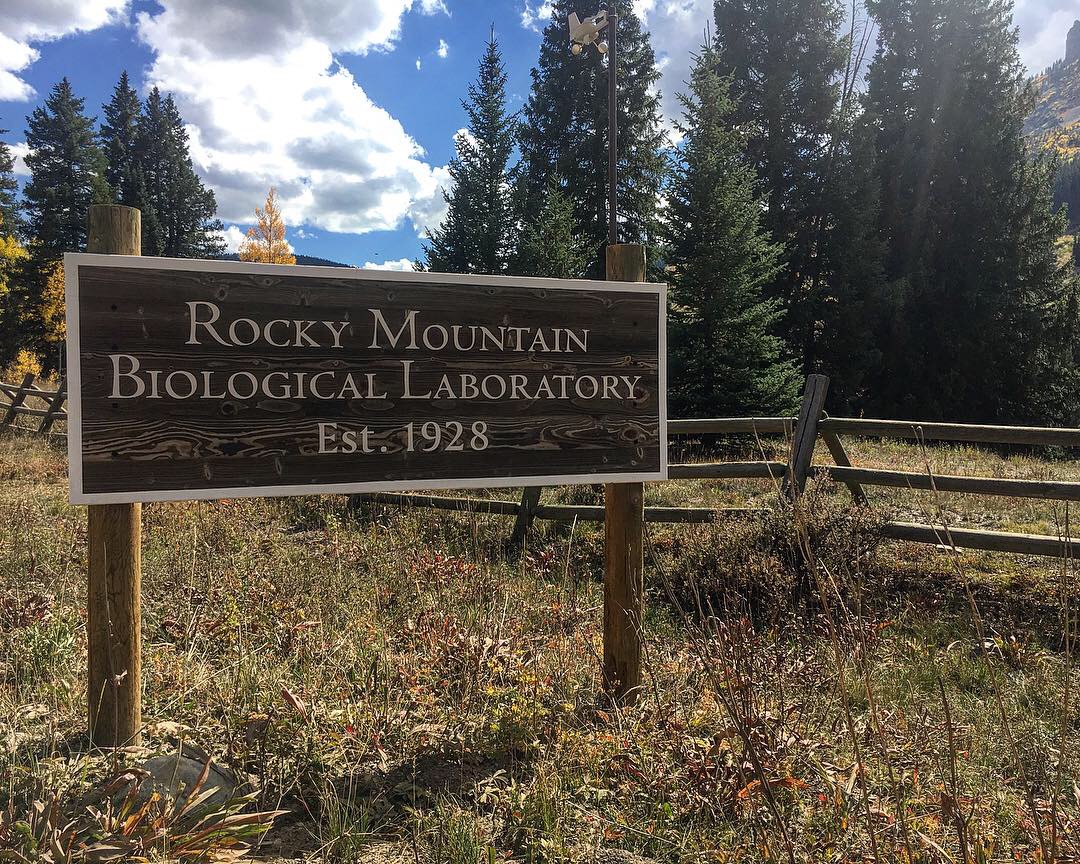By Isabella Oleksy — Many mountainous regions are warming faster than the global average, including the western United States. Ecosystems are changing in response to multiple environmental stressors such as drought, beetle outbreaks, dust deposition, and changing snowpack, some of which are exacerbated by climate anomalies and global change in general. Disentangling the effects of natural versus anthropogenic change is a challenge for scientists and for anticipating the future of western mountain ecosystems and resources.
Last month, several Natural Resource Ecology Laboratory Scientists from Colorado State University (also members of the Early Career Mountain Sentinels group) attended the MtnClim conference in Crested Butte, CO. This meeting is held every other year and organized by The Consortium for Integrated Climate Research in Western Mountains (CIRMOUNT), a collaborative, interdisciplinary consortium dedicated to understanding climates and ecosystems of western North American mountains that includes students, resource managers, industry, academia, and government scientists, and environmental non-profits. The Rocky Mountain Biological Laboratory (RMBL) was an appropriate host for the conference, given the history of research that has helped us gain a better understanding of ecosystem dynamics and response to global change. This year’s theme was ‘anticipating climate change impacts in mountains and embracing variability’.
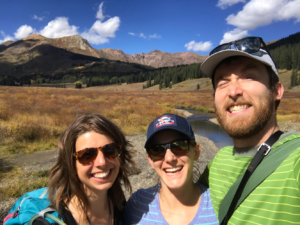
Graduate students from CSU: Isabella Oleksy, Abby Eurich, John Hammond. (photo: B. Olesky)
Legends in global change ecology John Harte and David Inyoue delivered plenary talks with insights into what we can gain from multi-decade field studies. “This was the first time I had heard directly from people involved in studies of this nature. It was astonishing what a difference it can make to have 40 years versus 10 years of data, especially in this era of such dramatic but non-uniform changes in climate,” reflects Abby Eurich, hydrologist in Stephanie Kampf’s research group. “I was pretty inspired by John Harte’s work and the way he combined a long-term, plot-scale experiment with large-scale space-for-time observations. Anytime people cut across scales like that I think it’s great,” remarked Timothy Weinman, Program Manager at Loch Vale Watershed, Rocky Mountain National Park.
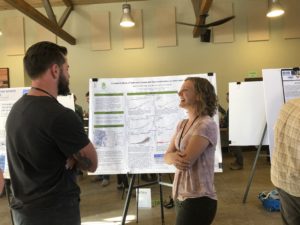
A fun, informative and interactive poster session!
Facilitating Collaboration & Incubating Ideas
MtnClim meetings are typically 4 days long with one day and one afternoon set aside for field trips. Meeting sizes range between 100-150 people who mostly stay on site, facilitating natural collaborations and socializing of conference attendees at all career stages. “We eat all our meals together, go on hikes during breaks, and share cabins. It’s very cozy. I always leave these meetings with new friends and collaborators and a revived sense of motivation to continue the research I’m doing,” commented Isabella Oleksy, a Ph.D. candidate in Jill Baron’s research group. “The common meals and space gave the conference an air of equality – nobody was superior or inferior and everyone was willing to listen and learn from each other. This was quite refreshing,” added Eurich.
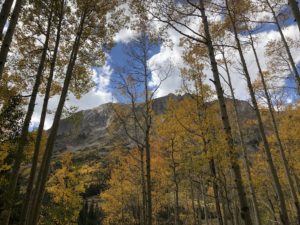
Fall colors were on display (photo: J. Klein).
Julia Klein, Professor in the Department of Ecosystem Science & Sustainability , gave a presentation on developing collaborative social-ecological solutions to sustainability challenges across mountainous areas worldwide in addition to leading a Mountain Sentinels workshop regarding innovations toward mountain sustainability. “It is definitely a meeting that emphasizes biophysical sciences in the Western US, so while it is useful to have a specific focus, I tried to broaden the conversation a bit with my presentation,” remarked Dr. Klein. She added, “for me, the conference was a bit of a reunion, as my PhD advisor at UC Berkeley was John Harte. Two of my fellow graduate students – Lara Kueppers (UC Berkeley) and Molly Cross (Wildlife Conservation Society) were also in attendance and we have all spend time together at RMBL in the past. We have stayed in touch as friends and collaborators and I continue to be inspired by John’s work and approach as well as by my former graduate school colleagues. ”
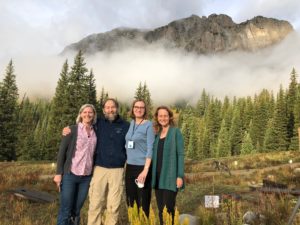
John Harte, keynote speaker, and three of his former students: Molly Cross, Lara Kueppers, Julia Klein.
The Future of MtnClim
The demographics of MtnClim and the CIRMOUNT community in general are changing. Conference organizer Andy Bunn announced on the last night of the conference that this year’s meeting brought together the most diverse and youngest group of scientists ever. The meeting provided a forum for early career scientists to present cutting-edge research on diverse topics ranging from incorporating backcountry citizen scientist observations into snow depth models, using machine-learning to predict drivers of lake productivity across mountain landscapes, and flying drones over forest stands to map variability of forest structure on severity of a tree-killing insect. The laid back atmosphere of the conference, in addition to a funded early-career session, make MtnClim a great place for young scientists to test and share new ideas and gain feedback before peer-review.
As a group, attendees discussed how future meetings can improve to broaden the scope of research presented and enable more disciplinary cross-over with an emphasis on emerging early-career leaders taking the reins. “There is definitely room for improvement in highlighting social science advances in mountainous areas,” remarked John Hammond. “We emphasized that if we want to increase diversity, we need to explicitly invite colleagues and acquaintances who may not be aware of the conference and community we are building.” Oleksy added, “it is clear that we have many challenges ahead of us regarding anticipating ecosystem changes in mountains and building resilience in the communities that live in and rely upon everything that mountains provide humanity. Even so, I left the meeting feeling optimistic that we can tackle these challenges, particularly if we continue to break down disciplinary boundaries and bring more diverse perspectives to the table.”
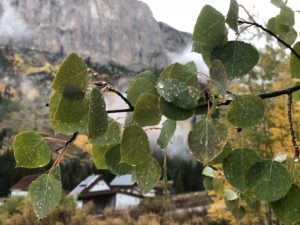
CIRMOUNT aligns with the goals of the U.S. federal Global Change Research Program, coordinates with the USGS Western Mountain Initiative, and was initially endorsed as a pilot regional project of the international Mountain Research Initiative. The next MtnClim meeting will take place in 2020 (location TBD), but readers can stay up-to-date by checking the CIRMOUNT website: https://www.fs.fed.us/psw/cirmount/ .
Isabella Olesky is a PhD candidate at Colorado State University and a member of the Early Career Mountain Sentinels.

